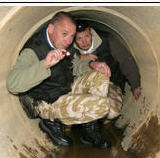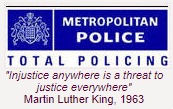Chapter 17: Some Philosophical thoughts in which we examine Logic and the absence of evidence
The Complete Mystery of Madeleine McCann™ :: Madeleine Beth McCann :: PeterMac's FREE e-book: What really happened to Madeleine McCann?
Page 1 of 1 • Share
 Chapter 17: Some Philosophical thoughts in which we examine Logic and the absence of evidence
Chapter 17: Some Philosophical thoughts in which we examine Logic and the absence of evidence
Chapter 17: Some Philosophical thoughts in which we examine Logic and the absence of evidence
Some Philosophical thoughts.
In which we examine Logic and the absence of evidence.
I want to go through this slowly, and at some length, partly because it is important that any error, misunderstanding, or false logic may be identified and challenged, and partly because the subject may not be familiar, or at least not currently at the forefront of people’s minds. For that reason some of the themes are repeated each time they become relevant.
Any who wish to explore further could do worse than to start with Wikipedia.
Once we have covered the logic and philosophy we can begin to apply it to the case in question.
Evidence of Absence.
‘Evidence of absence’ is evidence of any kind that suggests something is missing or that it does not exist.
We remember the traditional aphorism, "absence of evidence is not evidence of absence". But here we are considering positive evidence of this kind, and realise that is distinct from a lack of evidence or ignorance of that which, had it existed, should have been found already,.
When we say positive evidence, we mean of course the lack of something we might have expected to find. Not that we simply didn’t look, or didn’t find it, but that we did look, hard, and it was not there.
So there is a difference between saying - - - - I don’t know if it was there or not,
and saying firmly - - - - I can state that it was not there.
That is a significant difference, and philosophers and logicians down the ages have played with the concept.
One example
In some circumstances it can be safely assumed that if a certain event had occurred, evidence of it could be discovered by qualified investigators. In such circumstances it is perfectly reasonable to take the absence of proof of its occurrence as positive proof of its non-occurrence.
Irving Copi - Introduction to Logic (1953) p. 95Others have taken the concept further, and have refined the circumstances under which the lack of evidence moves from negative to positive proof.
The best remembered example is perhaps this one:
If someone were to assert that there is an elephant on the quad, then the failure to observe an elephant there would be good reason to think that there is no elephant there.
But if someone were to assert that there is a flea on the quad, then one’s failure to observe it would not constitute good evidence that there is no flea on the quad. The salient difference between these two cases is that in the one, but not the other, we should expect to see some evidence of the entity if it in fact existed.
Moreover, the justification conferred in such cases will be proportional to the ratio between the amount of evidence that we do have and the amount that we should expect to have if the entity existed. If the ratio is small, then little justification is conferred on the belief that the entity does not exist.
For example, in the absence of evidence rendering the existence of some entity probable, we are justified in believing that it does not exist, provided that
1) it is not something that might leave no traces and
2) we have comprehensively surveyed the area where the evidence would be found if the entity existed.
JP Moreland & WL Craig, Philosophical Foundations
It is settled in logic, as well as in most legal systems, that when two parties are in a discussion and one asserts a claim that the other disputes, the one who asserts has the burden of proof to justify or substantiate that claim.
There are exceptions to this. For example when one person asserts something which is held to be generally known or scientifically established.
In the language of logic - either a proposition is assumed to be true because it has not yet been proved false or a proposition is assumed to be false because it has not yet been proved true. This may have the effect of shifting the burden of proof to the person criticising the proposition. This is the basis of the scientific method.
In English law, for example, it is clear that the burden of proof is always on the Prosecution, which is required to show
1 That an offence known to law has been committed, and
2 That the accused committed it
But even here, there are times when although the burden of proof does not shift, inferences may be drawn from absence of evidence.
So, for example
Adverse inferences may be drawn in certain circumstances where before or on being charged, the accused:
- fails to mention any fact which he later relies upon and which in the circumstances at the time the accused could reasonably be expected to mention;
- fails to give evidence at trial or answer any question;
- fails to account on arrest for objects, substances or marks on his person, clothing or footwear, in his possession, or in the place where he is arrested; or
- fails to account on arrest for his presence at a place.
Criminal Justice and Public Order Act 1994
[This has in fact just been invoked in the case against the man accused of murdering the MP Joe Cox. (22/11/2016). He refused to offer any defence, and the jury was told they might draw proper inferences. He was found Guilty ]
And the Police Caution, given before questioning of a suspect has changed from
"You do not have to say anything unless you wish to do so, but what you say may be given in evidence."
to
"You do not have to say anything. But it may harm your defence if you do not mention when questioned something which you later rely on in court. Anything you do say may be given in evidence."
Police and Criminal Evidence Act 1984, s.28
The burden of proof is still on the prosecution, but the philosophical position of absence of evidence becoming evidence of absence is now covered. And note that it talks of of Harming the Defence, not proving the case. There must be other evidence. Only an inference is raised. Silence alone cannot convict.
So what do we learn
In order for Absence of Evidence to transmute into Evidence of Absence we need to show
1) it is not something that might leave no traces
2) a comprehensive survey of the area where the evidence would be found
3) Ideally using Qualified Investigators
A few more examples of how people have dealt with this
Argument from ignorance (argumentum ad ignorantiam), is also known as appeal to ignorance. Here ‘ignorance’ is used in the sense of "a lack of contrary evidence"
It is a fallacy in informal logic. It asserts that a proposition is true because it has not yet been proved false (or vice versa). This is a type of false dichotomy in that it excludes a third option, which is that there may have been an insufficient investigation, and therefore there is insufficient information to prove the proposition be either true or false.
Nor does it allow the admission that the choices may in fact not be two (true or false), but may be as many as four, True, False, Unknown, Unknowable
This fallacy can be very convincing and is considered by some to be a special case of a false dilemma or false dichotomy in that they both fail to consider alternatives. A false dilemma may take the form:
If a proposition has not been disproved, then it cannot be considered false and must therefore be considered true.
If a proposition has not been proved, then it cannot be considered true and must therefore be considered false.
Such arguments attempt to exploit the facts that (a) true things can never be disproved and (b) false things can never be proved. In other words, appeals to ignorance claim that the converse of these facts are also true.
Therein lies the fallacy.
Duco A. Schreuder, Vision and Visual Perception
Or again -
Because there is always the faint possibility that evidence hasn't been observed yet, a common maxim is that "absence of evidence is not evidence of absence" - and is often used by people to hang on to their beliefs even when faced with a lack of evidence for them.
However, this is technically an incorrect maxim; if evidence is lacking when we expect it to be abundant, then it very much allows us to dismiss a hypothesis, and absence of evidence clearly becomes evidence of absence.
A parting shot
The only case in which absence of evidence is not evidence of absence is when no attempt whatsoever has been made to obtain evidence ...
But that is not absence of evidence, it is absence of investigation.
And we can compare and contrast all the above with evidence of existence, where just one piece of credible evidence may establish the point beyond doubt
Why is this important ?
Back to the real world
Let us take the above and apply it to the question of the Complete Mystery of the Disappearance of Madeleine Beth McCann
We surely look for "evidence of existence", where just one good piece of evidence would establish the point. (‘Existence’ meaning ‘of the abduction’)
It is important to stress, repeatedly, the Burden of proof has not moved. It is still on the McCanns to show evidence of Abduction. Merely repeating “Abduction” endlessly and threatening to sue for libel those who question the assertion is NOT proof sufficient to move the burden of proof to sceptics.
Remember that in a criminal case the prosecution has to show that a crime known to law has been committed before moving on to the person who committed it.
So let us try to help the McCanns, and those acting on their behalf - the police officers, Forensic experts, dog handlers and all the other professionals, including their lawyers, family members and witnesses, and list what the Qualified Investigators would concentrate on in their comprehensive survey of the area where the evidence would be found.
In a case of Abduction they would look for
- point of entry, point of exit
- evidence of physical presence at the location, inside and outside
- fingerprints, DNA, blood, saliva, other bodily fluids, hair, skin cells,
- dust, mud, gravel, any artefact ‘foreign’ to the scene, fibres from clothing,
- evidence of disturbance of bedclothes, movement of furniture,
- evidence of searching,
- footprints, shoe marks, scuff marks, glove marks
- and much more on a detective’s list
but we find - Nothing. Not one piece of good evidence to establish the point beyond doubt.
And we reiterate that this alleged crime was emphatically NOT
1) . . . something that might leave no traces
but the absence of evidence WAS after
2) a comprehensive survey of the area where the evidence would be found
3) [ . . .] using Qualified Investigators
During extensive interviews of the main players, and of many other people in and around the area, no evidence was found of a credible suspect. The one that was kept in the public domain for years was officially dismissed by the senior British detective in charge of the operation
This level of absence of evidence of intrusion and of abduction surely begins to amount to evidence of absence.
Simply saying ‘there is no alternative, what other explanation is there ?”
as Gerry McCann did outside the court in Portugal, was perhaps supposed to be a rhetorical question.
It is not. There are many other possible explanations, some stronger than others, and some backed by other available evidence, both positive and negative.
Saying, as they do on the web site - The abduction is for us the only hypothesis - may simply be evidence of a closed mind, but may indicate something else.
On Proof
We talk of Proof. Simply stating something does not make it so. Even if stated several times, the position does not alter. Charles Dodgson (Lewis Carroll) used the device humorously in the epic nonsense poem The Hunting of the Snark,
"Just the place for a Snark!" the Bellman cried,
As he landed his crew with care;
Supporting each man on the top of the tide
By a finger entwined in his hair.
"Just the place for a Snark! I have said it twice:
That alone should encourage the crew.
Just the place for a Snark! I have said it thrice:
What I tell you three times is true."
This is instantly recognisable as ridiculous nonsense, and yet it was exactly the technique used by the propaganda minister of the Third Reich.
". . in the big lie there is always a certain force of credibility; because the broad masses of a nation are always more easily corrupted in the deeper strata of their emotional nature than consciously or voluntarily,"
often misquoted or paraphrased as:
"The bigger the lie, the more it will be believed."
(It is actually from Mein Kampf (1925), A.H. vol 1, ch 6 “If you repeat a lie often enough, people will believe it, and you will even come to believe it yourself.”)
Variants include
If you repeat a lie often enough, it becomes the truth.
If you repeat a lie often enough, people will believe it.
If you repeat a lie many times, people are bound to start believing it.
A digression on Belief
Now let us look at what the “believers” say.
I believe Madeleine was abducted . . . But they then fade out.
Not one, so far as I know, has added the subordinate clause . . . because there is clear evidence of X, Y, or Z.
I believe the parents were not involved in her disappearance . . . but again they fade out.
Not one, so far as I know, has added the subordinate clause . . . because there is clear evidence that X, Y, or Z.
They simply express a belief.
At times this is based on totally irrelevant supposed knowledge of the previous ‘good conduct’ of the parents, or the fact that they are professionals.
The most notorious example of this was the hapless Mrs Martorell, speaking for Carter-Ruck, under oath in the High Court of England, who had indirectly expressed her belief, no fewer than three times, that Madeleine had been abducted, but when asked on what evidence she based that belief had no useful answer, and simply faded into an embarrassed silence. Tugendhat J realised the significance of that, and mused, on the record, about the legal situation if it could ever be shown that there had been no abduction.
The next bit is sometimes argued over, but is a neat, if simplistic way of putting it.
Belief without evidence is strictly called Faith
Faith is different from belief.
Belief is a statement or idea of pre-knowledge or pre-understanding that can be verified and tested using the scientific method. A belief can be proven true or false.
Faith is irrational belief, in the sense that it is belief that cannot be tested.
If someone who has never seen the sea says “I believe that the sea flows and recedes . .” this is susceptible to verification and testing.
If someone says “I have Faith that one day we shall be visited by extra-terrestrial beings . . .” there is simply nothing we can usefully say, except perhaps “I am sorry, but I do not share your Faith.”
So the statement “I have Faith that the parents were not involved” - is unanswerable. It can also be cheerfully ignored as it adds nothing to the debate.
Whereas “I believe that the parents were not involved” can be tested, forensically, that is - in a Court of Law
So where does this take us ?
If we apply the test to everything that the McCanns and the Tapas group reported and what the experts discovered, what we find is a total Absence of any Evidence of abduction.
Abduction of a 3 yr. old child with a history of unsettled sleep, from a cramped and darkened bedroom she was sharing with two other small children, with shuttered and locked windows, in an apartment with a locked front door, the only unlocked entrance directly facing the location where the parents and friends were dining, and carrying out overlapping visits, each every half hour . . . and so passing and re-passing every few minutes
is NOT, on any test
1). . . something that might leave no traces
We may wish to recall that there was
2) a comprehensive survey of the area where the evidence would be found
and that
3) [. . . ] Qualified Investigators - were in fact used
And so the Absence of Evidence does allow us with some considerable force to argue that this provides overwhelming Evidence of Absence of the Abduction.
Remember, as we have observed, a single credible piece of evidence would be sufficient to challenge this proposition.
Of course, as we know there is evidence, but what there is indicates the exact opposite scenario.
The changing stories, the inconsistencies, the forged Last photo, the nonsense stories about shutters and about simultaneously wide-open and tight-closed whooshing curtains, the clear prevarication by witnesses who should reasonably have been expected to tell the truth, gross and blatant alterations in testimony and public stories apparently to retrofit inconvenient findings or alternate theories being put forward, and above all the alerts of the highly trained and wholly reliable dogs . .all this is clear positive evidence that the abduction story is a fabrication.
When we add this conclusion to the evidence of absence of abduction, we find that it all firmly points in the direction the PJ, and the Public Prosecutor indicated.
We must surely be permitted to “purport” the theory, and to agree with Police and Prosecutors that
B) a simulation of an abduction took place;
D) Kate McCann and Gerald McCann are involved in the concealment of the cadaver of their daughter, Madeleine McCann;
F) from what has been established up to now, everything indicates that the McCann couple, in self-defence, doesn’t want to deliver the cadaver immediately and voluntarily, and there is a strong possibility that it was moved from the initial place of deposition.
A report by Chief Inspector Tavares de Almeida to the Coordinator of the Criminal Investigation
NUIPC-201/07.0 GALGS
The archiving dispatch perhaps put this whole issue somewhat more succinctly than I have managed. But then they are trained and skilled and experienced in their profession.
« Despite all of this, it was not possible to obtain any piece of evidence that would allow for a reasonable man, under the light of the criteria of logics, of normality and of the general rules of experience, to formulate any lucid, sensible, serious and honest conclusion about the circumstances under which the child was removed from the apartment (whether dead or alive, whether killed in a neglectful homicide or an intended homicide, whether the victim of a targeted abduction or an opportunistic abduction), nor even to produce a consistent prognosis about her destiny and inclusively – the most dramatic – to establish whether she is still alive - or if she is dead, as seems more likely.
The Republic’s Prosecutor (José de Magalhães e Menezes)/The Joint General Prosecutor (João Melchior Gomes) in: Processo 201/07.0 GALGS - Volume XVII - pages 4645-4649 (Public Prosecutor's Archiving Dispatch)»
____________________
PeterMac's FREE e-book
Gonçalo Amaral: The truth of the lie
CMOMM & MMRG Blog
 MAGA
MAGA
 MBGA
MBGA
 Similar topics
Similar topics» PeterMac's FREE e-book: Chapter 51 Some random unrelated thoughts
» Chapter 28: 'The Pool Photo refuses to go away' + Appendix (Chapter 29) Two Photos that tell an important story
» PeterMac's FREE e-book: CHAPTER 63 Addendum A response to critiques of Chapter 63 – SmithGerryMan
» Interesting new blog - Looking For Madeleine: A chapter by chapter review
» PeterMac's new chapter for his e-Book: Chapter 35: Mirage
» Chapter 28: 'The Pool Photo refuses to go away' + Appendix (Chapter 29) Two Photos that tell an important story
» PeterMac's FREE e-book: CHAPTER 63 Addendum A response to critiques of Chapter 63 – SmithGerryMan
» Interesting new blog - Looking For Madeleine: A chapter by chapter review
» PeterMac's new chapter for his e-Book: Chapter 35: Mirage
The Complete Mystery of Madeleine McCann™ :: Madeleine Beth McCann :: PeterMac's FREE e-book: What really happened to Madeleine McCann?
Page 1 of 1
Permissions in this forum:
You cannot reply to topics in this forum







































